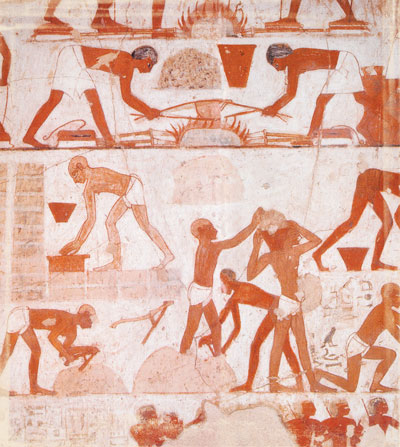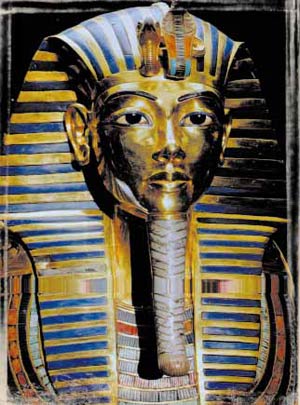Bigotry: The Dark Danger
Miracles of the Qur’an Vol.1

DOWNLOAD THE BOOK
CHAPTERS OF THE BOOK
< <
5 / total: 6
Part 3 - The Historical Miracles of the Qur'anThe Word "Haman" in the Qur'an
The information given in the Qur'an about ancient Egypt reveals many historical facts that had remained undisclosed until recent times. These facts also indicate to us that every word in the Qur'an has been revealed by sure wisdom. Haman is a character whose name is mentioned in the Qur'an, along with the Pharaoh. He is recorded in six different places of the Qur'an as one of the closest men to the Pharaoh. Surprisingly the name of Haman is never mentioned in those sections of the Torah pertaining to the life of Moses. However, the mention of Haman can be found in the last chapters of the Old Testament as the helper of a Babylonian king who inflicted many cruelties on the Israelites approximately 1,100 years after Moses. Some non-Muslims, who claim that the Prophet Muhammad (peace be upon him) wrote the Qur'an by copying from the Torah and the Bible, also assert that during the process, he transferred some of the subjects related in these books into the Qur'an incorrectly. The absurdity of these claims was demonstrated only after the Egyptian hieroglyphic alphabet had been deciphered, approximately 200 years ago, and the name "Haman" discovered in the ancient scripts. Before these discoveries, the writings and inscriptions of ancient Egypt could not be understood. The language of ancient Egypt was hieroglyphic, which survived through the ages. However, with the spread of Christianity and other cultural influences in the 2nd and 3rd centuries AD, Egypt forsook its ancient beliefs as well as hieroglyphic writing. The last known example of the use of hieroglyphic writing was an inscription dated 394 AD. Then that language was forgotten, leaving nobody who could read and understand it. And that was the situation until some 200 years ago… The mystery of ancient Egyptian hieroglyphics was solved in 1799 by the discovery of a tablet called the "Rosetta Stone" dating back to 196 B.C. The importance of this inscription was that it was written in three different forms of writing: Hieroglyphics, demotic (a simplified form of ancient Egyptian hieratic writing) and Greek. With the help of the Greek script, the ancient Egyptian writings were decoded. The translation of the inscription was completed by a Frenchman named Jean-Françoise Champollion. Hence a forgotten language and the events related in it were brought to light. In this way, a great deal of knowledge about the civilization, religion and social life of ancient Egypt became available. Through the decoding of hieroglyph, an important piece of knowledge was revealed: the name "Haman" was indeed mentioned in Egyptian inscriptions. This name was referred to in a monument in the Hof Museum in Vienna.22 In the dictionary of People in the New Kingdom, that was prepared based on the entire collection of inscriptions, Haman is said to be "the head of stone quarry workers".23 The result revealed a very important truth. Unlike the false assertion of the opponents of the Qur'an, Haman was a person who lived in Egypt at the time of Moses, who had been close to the Pharaoh, and had been involved in construction work, just as imparted in the Qur'an. Furthermore, the verse in the Qur'an describing the event where the Pharaoh asked Haman to build a tower is in perfect agreement with this archaeological finding: "Pharaoh said, 'Council, I do not know of any other god for you apart from Me. Haman, kindle a fire for me over the clay and build me a lofty tower so that perhaps I may be able to climb up to Moses' god! I consider him a blatant liar.'" (The Qur'an, 28:38) In conclusion, the existence of the name Haman in the ancient Egyptian inscriptions not only rendered the fabricated claims of the opponents of the Qur'an worthless, but also confirmed one more time the fact that the Qur'an comes from God. In a miraculous way, the Qur'an conveys to us historical information that could not have been possessed or understood at the time of the Prophet. Titles of Egyptian Rulers in the Qur'an
Moses was not the only prophet who lived in the lands of Egypt in the history of ancient Egypt. The Prophet Joseph had lived in Egypt long before the time of Moses. We encounter a certain parallel while reading about the stories of Moses and Joseph. While addressing the Egyptian ruler at the time of Joseph, the work "malik" (the King) is used in the Qur'an: "The King (malik) said, 'Bring him (Joseph) to me straight away! so I may draw him very close to me.' When he had spoken with him, he declared, 'Today you are trusted, established in our sight.'" (The Qur'an, 12:54) In contrast, the ruler at Moses' time is referred to as the "Pharaoh": "We gave Moses nine Clear Signs. Ask the tribe of Israel about when he came to them and Pharaoh said to him, 'Moses, I think you are bewitched.'" (The Qur'an, 17:101) Historical records available today show us the reason for the different nomenclature of these rulers. The word "pharaoh" was originally the name given to the royal palace in ancient Egypt. The rulers of the old dynasty did not use the title. The use of the word pharaoh as the title of the ruler did not start until the "New Kingdom" era of Egyptian history. This period started with the 18th dynasty (1539-1292 BC), and by the 20th dynasty (945-730 BC) the word "pharaoh" was adopted as title of respect. Therefore the miraculous nature of the Qur'an is manifested here once again: Joseph lived at the time of the Old Kingdom, and hence the word "malik" was used for the Egyptian ruler rather than "pharaoh". On the contrary, since Moses lived at the time of the New Kingdom, the ruler of Egypt is addressed as "pharaoh". There is no doubt that one has to have a knowledge of the history of Egypt in order to make such a distinction. However, the history of Ancient Egypt was completely forgotten by the 4th century, as hieroglyphics could no longer be understood, and was not rediscovered until the 19th century. Therefore, there was no in-depth knowledge of Egyptian history available when the Qur'an was revealed. This fact is yet another one of countless pieces of evidence proving that the Qur'an is the word of God.
|
5 / total 6
You can read Harun Yahya's book Miracles of the Qur’an Vol.1 online, share it on social networks such as Facebook and Twitter, download it to your computer, use it in your homework and theses, and publish, copy or reproduce it on your own web sites or blogs without paying any copyright fee, so long as you acknowledge this site as the reference.


